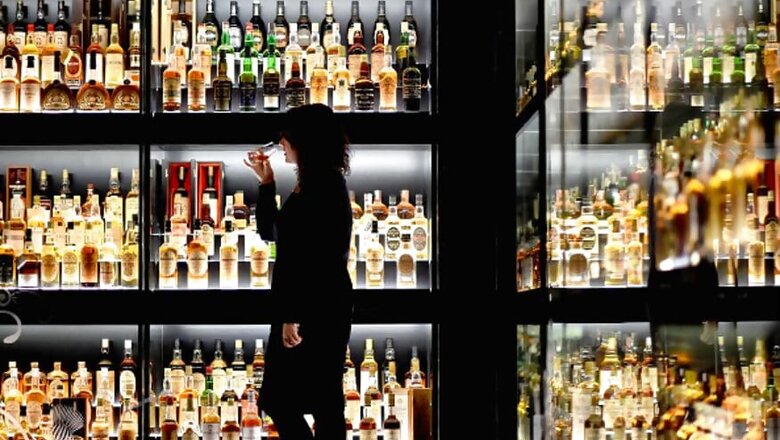
views
New Delhi: Barber shops and salons located in green and orange zones will be allowed to open from Monday besides sale of non-essential items by e-commerce platforms during the third phase of the lockdown which will be in force till May 17.
Sale of liquor will be allowed with certain conditions in all zones -- green, orange and red -- barring containment areas.
These exemptions were given by the Ministry of Home Affairs on Friday, while extending the lockdown for two more weeks.
There are no restrictions on sale of non-essential items by e-commerce platforms in green and orange zones, a home ministry spokesperson clarified on Saturday, adding barber shops and salons are also allowed to open in these areas.
In red zones, the e-commerce companies are allowed to sell only essential commodities.
Barber shops and salons are not allowed to open in red zones as these are services not goods.
Liquor sale is allowed in green, orange and red zones if it is a standalone shop and not located in markets or malls.
In liquor shops, customers will have to maintain minimum six feet distance (2 gaz ki doori) from each other, and also ensure that not more than five persons are present at one time at the shop.
These exemptions will be effective from May 4 when the third phase of the lockdown will begin.
Sale of liquor, opening of barber shops and salons have not been allowed during the first two phases of lockdown, which began on March 25.
Sale of non-essential items by e-commerce companies were also not allowed.
On allowing domestic helps to work in red zones, a home ministry official said resident welfare associations should take a call regarding allowing the movement of outsiders.
But health protocols have to be maintained by domestic helps as well as employers, and the responsibility lies with the person who employs maids in case of any mishappening.
Classifications of districts into 'Red', 'Orange' and 'Green' zones is done based on COVID-19 risk profiling.
A district will be considered as a 'Green' zone if there are no confirmed cases so far or there has been no reported case for the past 21 days.
According to the health ministry, as on Friday, there were 130 'Red' zones in the country with maximum of 19 in Uttar Pradesh, followed by 14 in Maharashtra.
The number of 'Orange' Zones was 284 and 'Green' was 319.
All the districts of the national capital have been put under 'Red' zone.
According to the home ministry, travel by road (inter-state), rail and air and metro are banned across the country during the third leg of the lockdown.
The home ministry may give permission in special cases depending on the urgency.
Educational, training institutions like schools, colleges, coaching centres are not allowed to open during the lockdown. However, online, distance learning is permitted.
Hospitality services, including hotels and restaurants, will remain shut.
Places of large gatherings like gym, theatres, malls, bars, religious, social and political gatherings, movement of people between 7 pm and 7 am for non-essential activities are banned.
Every activity, except movement of persons for supply of essential goods and services and for medical emergencies, OPDs and medical clinics, will remain prohibited in containment areas of a red zone.
Outside containment areas of a red zone, plying of rickshaw, taxi, buses, barber shops and spas remain prohibited.
What is allowed outside containment areas of a Red Zone (with restrictions):
In urban areas
Movement of people and vehicles for permitted activities, industrial establishments like SEZs, manufacturing of essential goods like drugs, medical devices, etc. and their supply chain, manufacturing of IT hardware, jute industry, construction (if workers residing on site).
Standalone shops, shops in neighbourhood and residential complexes (essential and non-essential items), e-commerce activities for essential goods, private offices with 33 per cent strength, operations of homes for senior citizens, children, destitute etc., government offices, and emergency, health, sanitation and security services.
In rural areas
All industrial and construction activities, all shops except in shopping malls, all agriculture, animal husbandry and plantation activities, health services, financial sector including banks, NBFCs etc., public utilities, courier and postal services, print, electronic media, IT, ITeS, warehouses services by self-employed persons except barbers.
Orange Zone:
What is prohibited
Inter and intra-districts plying of buses, except those permitted by the MHA.
Permitted activities
All activities permitted in red zone (outside containment zone), Taxi (driver with 2 passengers only).
Inter-district movement of people and vehicles for permitted activities, 4 wheelers with 2 passengers with driver, pillion riding on 2 wheelers.
Green Zone:
All activities allowed except those prohibited throughout the country. Buses and bus depots can operate with 50 per cent capacity.
According to the home ministry, states and union territories may put restrictions on the above permitted activities, based on their assessment required to contain COVID-19.
The lockdown was first announced by Prime Minister Narendra Modi on March 24 in a bid to combat the novel coronavirus pandemic.
It was extended till May 3. On Friday, again the government announced further extension of the lockdown for two more weeks till May 17.




















Comments
0 comment